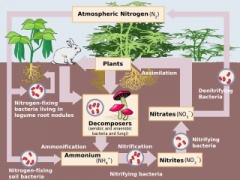![]()
![]()
![]()
Use LEFT and RIGHT arrow keys to navigate between flashcards;
Use UP and DOWN arrow keys to flip the card;
H to show hint;
A reads text to speech;
8 Cards in this Set
- Front
- Back
|
Anthropocene Epoch |
Anthropocene Epoch, unofficial interval of geologic time, making up the third worldwide division of the Quaternary Period (2.6 million years ago to the present), characterised as the time in which the collective activities of human beings (Homo sapiens) began to substantially alter Earth's surface, atmosphere, oceans |
|
|
Nitrogen cycle |

The nitrogen cycle is the biogeochemical cycle by which nitrogen is converted into various chemical forms as it circulates among the atmosphere and terrestrial and marine ecosystems. The conversion of nitrogen can be carried out through both biological and physical processes. |
|
|
Effects of climate change |
Change will continue through this century and beyond Temperatures will continue to rise Frost-free season (and growing season) will lengthen Changes in precipitation patterns More droughts and heat waves Hurricanes will become stronger and more intense Sea level will rise 1-4 feet by 2100 Arctic likely to become ice-free |
|
|
Permafrost |
A thick subsurface layer of soil that remains below freezing point throughout the year, occurring chiefly in polar regions. |
|
|
Gas composition of the atmosphere |
Nitrogen accounts for 78% of the atmosphere, oxygen 21% and argon 0.9%. Gases like carbon dioxide, nitrous oxides, methane, and ozone are trace gases that account for about a tenth of one percent of the atmosphere. |
|
|
Ozone layer |
The primary cause of ozone depletion is the presence of chlorine-containing source gases (primarily CFCs and related halocarbons). In the presence of UV light, these gases dissociate, releasing chlorine atoms, which then go on to catalyze ozone destruction. |
|
|
Ocean acidity |
Ocean acidification is the ongoing decrease in the pH of the Earth's oceans, caused by the uptake of carbon dioxide (CO2) from the atmosphere. An estimated 30–40% of the carbon dioxide from human activity released into the atmosphere dissolves intooceans, rivers and lakes. |
|
|
Australia's biodiversity impacts |
Introduction of new species - non-native species often take over land and compete with the natural species for food. This lowers biodiversity. Habitat alteration and destruction - clearing land for homes, industry and agriculture is the biggest threat to the delicate balance of biodiversity. This is called deforestation. Deforestation leads to erosion of the land and fragmentation of natural environments. Pollution and climate change - pollution kills species through short-term effects like the use of pesticides and long-term effects like climate change. |

